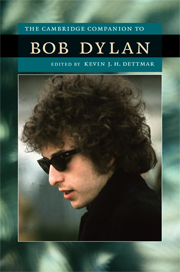Book contents
- Frontmatter
- Introduction
- Part I Perspectives
- 1 Bob Dylan and the Anglo-American tradition
- 2 Bob Dylan and Rolling Thunder
- 3 Bob Dylan as songwriter
- 4 Bob Dylan as performer
- 5 Bob Dylan and collaboration
- 6 Bob Dylan and gender politics
- 7 Bob Dylan and religion
- 8 Bob Dylan and the Academy
- 9 Bob Dylan as cultural icon
- Part II Landmark Albums
- Works cited
- Index
6 - Bob Dylan and gender politics
from Part I - Perspectives
Published online by Cambridge University Press: 28 May 2009
- Frontmatter
- Introduction
- Part I Perspectives
- 1 Bob Dylan and the Anglo-American tradition
- 2 Bob Dylan and Rolling Thunder
- 3 Bob Dylan as songwriter
- 4 Bob Dylan as performer
- 5 Bob Dylan and collaboration
- 6 Bob Dylan and gender politics
- 7 Bob Dylan and religion
- 8 Bob Dylan and the Academy
- 9 Bob Dylan as cultural icon
- Part II Landmark Albums
- Works cited
- Index
Summary
I was 12 when I heard “Lay, Lady, Lay.” Bob Dylan's Greatest Hits, Vol. 2 had just been released and “Lady” saturated the air. I played it over and over in my neighbor's basement, and sank into my first real swoon. “His clothes are dirty but his hands are clean / And you're the best thing that he's ever seen . . .” This man with dirty clothes and clean hands was, in my dreams, Bob Dylan. Romance novels and their fluttering women who needed a rough man's touch and soap operas, in which bad-girl Veronicas competed with good-girl Bettys, left me cold. Those mass-media depictions of women seemed narrow and outdated next to the powerful and exciting promise of feminism and sexual liberation. Strange, then, that the conventional gender dynamic on “Lay, Lady, Lay” clicked with my nascent sexuality; for me, Dylan was the one to crack open the door. Once I was hooked, I pored over the history of this tousled, sensitive man-boy. I hung on every tawdry tale in Tony Scaduto's 1971 Dylan biography. A more nuanced picture of him emerged from repeated listenings to Bringing It All Back Home, Highway 61 Revisited, and Blonde on Blonde, as his point of view alternated between wounded lover and acerbic appraiser. Eventually, his protest songs and poetic excursions displaced my lust, and I came to love him for his mind. Still, when I'd hear, “Whatever colors you have in your mind / I'll show them to you and you'll see them shine,” I knew Dylan held out a key to my creativity, and a promise. He would introduce me to the world of art and grownups and he would escort me into it, loving me for who I was, in my essence.
- Type
- Chapter
- Information
- The Cambridge Companion to Bob Dylan , pp. 80 - 86Publisher: Cambridge University PressPrint publication year: 2009
- 18
- Cited by

